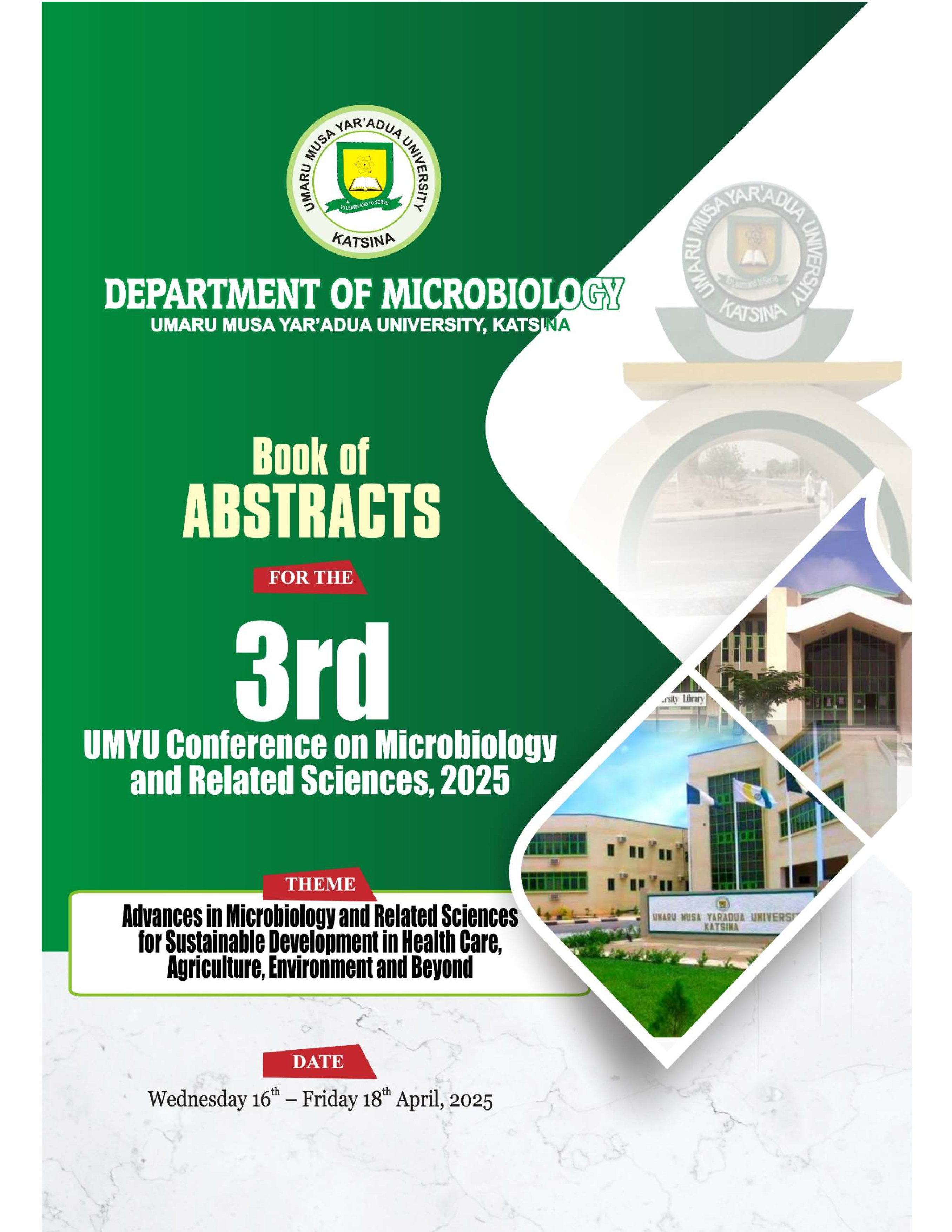Valorization of Yam Peel Waste for Single-Cell Protein Production Using Aspergillus niger
DOI:
https://doi.org/10.47430/ujmr.25103.023Keywords:
Aspergillus niger, single cell protein, yam peels, submerged fermentationAbstract
Study’s Excerpt:
- Aspergillus niger was used to produce single-cell protein from yam peel waste.
- Yam peels showed high carbohydrate content (81.73%) and supported fungal growth.
- Biomass yield was higher on yam peel (0.4 OD) than on commercial YEPD medium (0.23 OD).
- Yam peel substrate proved a viable low-cost medium for SCP production.
- The study promotes SCP production as a use for agro-waste and pollution control.
Full Abstract:
Agro-industrial waste is a source of nutrients and compounds that can be used to support microbial growth in fermentation processes for the production of bio-products such as enzymes, antibiotics, or single-cell proteins. The microbial biomass is a source of proteins with several advantages over traditional protein sources. This study aimed to produce single-cell protein (SCP) from Aspergillus niger using yam peels as substrate. Aspergillus niger was isolated from garden soil using Sabouraud dextrose agar (SDA) and characterized accordingly. Yam peels a restaurant in processed and analyzed for proximate composition according to standard protocols. The isolate was subjected to submerged fermentation using commercially prepared yeast extract peptone dextrose (YEPD), and the yam peel substrate for a period of 7days on a rotary shaker. Results show that Aspergillus niger isolates had dark to brown colonies with black conidial heads and a pale yellow colour on the reverse of the SDA plate. Microscopically, the conidiophore extended from its hyphae, carrying black globular conidia. Proximate composition of the yam peels substrate was found to contain carbohydrates (81.73%), lipids (4.17%), proteins (3.5%), moisture (5.19%), ash (5.4%), and fiber (1.85%). Support for higher fungal biomass was observed on yam peel substrate, which attained 0.4 OD (optical density), while the maximum growth on the commercially prepared media (YEPD) was 0.23 OD. Thus, the Yam peel substrate supported significantly higher A. niger biomass yield (0.4 OD) compared to commercial YEPD medium (0.23 OD). It is recommended that agro-industrial wastes such as yam peels and related wastes be used to enhance production of SCP, thereby reducing pollution caused by improper disposal of agro-industrial wastes.
Downloads
References
Aidoo, R., Kwofie, E. M., Adewale, P., Lam, E., & Ngadi, M. (2023). Overview of single cell protein: Production pathway, sustainability outlook, and digital twin potentials. Trends in Food Science & Technology, 138, 577–598. https://doi.org/10.1016/j.tifs.2023.07.003
Anupama, & Ravindra, P. (2001). Studies on production of single cell protein by Aspergillus niger in solid state fermentation of rice bran. Brazilian Archives of Biology and Technology, 44(1), 79–88. https://doi.org/10.1590/S1516-89132001000100011
AOAC International. (2016). Official Methods of Analysis of AOAC International (20th ed.). Gaithersburg, MD, USA: AOAC International. https://www.aoac.org/scientific-solutions/standards-and-official-methods/
Aruna, T. E., Aworh, O. C., Raji, A. O., & Olagunju, A. I. (2017). Protein enrichment of yam peels by fermentation with Saccharomyces cerevisiae (BY4743). Annals of Agricultural Sciences, 62(1), 33–37. https://doi.org/10.1016/j.aoas.2017.01.002
Bratosin, B. C., Darjan, S., & Vodnar, D. C. (2021). Single Cell Protein: A Potential Substitute in Human and Animal Nutrition. Sustainability, 13(16), Article 16. https://doi.org/10.3390/su13169284
Ezekiel, O. (2013). Solid State Fermentation of Cassava Peel with Trichoderma viride (ATCC 36316) for Protein Enrichment. https://www.academia.edu/73430689/Solid_State_Fermentation_of_Cassava_Peel_with_Trichoderma_viride_ATCC_36316_for_Protein_Enrichment
Growth report. (2024). Animal Protein Market Demand and Growth Insights 2024. https://www.usdanalytics.com/industry-reports/animal-protein-market
Habib, M. A., Abdu, P., Kwanashie, C. N., Kabir, J., & Negedu, A. (2015). Isolation and identification of Aspergillus species from poultry feeds in Kaduna State, Nigeria. 3(2).
Helal, M., Abdelhamid, A. M., Mohammed, F. O., & Fathy, R. H. (2022). Single Cell-Protein Production from Potato (Solanum tuberosum L.) Processing Waste by using Candida utilis NRRL Y-900. 2(2), 55–64.
Janssen, M., Wijffels, R. H., & Barbosa, M. J. (2022). Microalgae based production of single-cell protein. Current Opinion in Biotechnology, 75, 102705. https://doi.org/10.1016/j.copbio.2022.102705
Kumar, R., Raj, T., Næss, G., Sørensen, M., & Dhawan, V. (2024). Opportunities and challenges in single-cell protein production using lignocellulosic material. Biofuels, Bioproducts and Biorefining, 18(1), 310–321. https://doi.org/10.1002/bbb.2563
Madika, A. (2016). Production of single cell protein from pineapple waste using saccharomyces cerevisiae. 19(1), 10–16.
Nirmal, N., Anyimadu, C. F., Khanashyam, A. C., Bekhit, A. E. A., & Dhar, B. K. (2025). Alternative Protein Sources: Addressing Global Food Security and Environmental Sustainability. Sustainable Development, 33(3), 3958–3969. https://doi.org/10.1002/sd.3338
Olawale, B. I., Iliyasu, M. Y., Musa, B., Abdulrahman, A., Umar, A. F., Olawale, B. I., Iliyasu, M. Y., Musa, B., Abdulrahman, A., & Umar, A. F. (2021). Production of Bioethanol by Co-Culture of Aspergillus niger and Saccharomyces cerevisiae using Watermelon Peels as Substrate. Path of Science, 7(10), Article 10. https://doi.org/10.22178/pos.75-10
Onu, C. E., Nweke, C. N., & Nwabanne, J. T. (2022). Modeling of thermo-chemical pretreatment of yam peel substrate for biogas energy production: RSM, ANN, and ANFIS comparative approach. Applied Surface Science Advances, 11, 100299. https://doi.org/10.1016/j.apsadv.2022.100299
Roy, D., & Bhowal, J. (2021). Bioconversion of Mandarin Orange Peels by Aspergillus oryzae and Penicillium sp. In D. Ramkrishna, S. Sengupta, S. Dey Bandyopadhyay, & A. Ghosh (Eds.), Advances in Bioprocess Engineering and Technology (pp. 13–20). Springer. https://doi.org/10.1007/978-981-15-7409-2_2
Sharif, M., Zafar, M. H., Aqib, A. I., Saeed, M., Farag, M. R., & Alagawany, M. (2021a). Single cell protein: Sources, mechanism of production, nutritional value and its uses in aquaculture nutrition. Aquaculture, 531, 735885. https://doi.org/10.1016/j.aquaculture.2020.735885
Sharif, M., Zafar, M. H., Aqib, A. I., Saeed, M., Farag, M. R., & Alagawany, M. (2021b). Single cell protein: Sources, mechanism of production, nutritional value and its uses in aquaculture nutrition. Aquaculture, 531, 735885. https://doi.org/10.1016/j.aquaculture.2020.735885
Thiviya, P., Gamage, A., Kapilan, R., Merah, O., & Madhujith, T. (2022). Single Cell Protein Production Using Different Fruit Waste: A Review. Separations, 9(7), Article 7. https://doi.org/10.3390/separations9070178
Trafimovich, Y. (2023). Making A Spore Suspension Of Aspergillus: A Step-By-Step Guide | MedShun. https://medshun.com/article/how-to-make-spore-suspension-of-aspergillus
Ye, L., Bogicevic, B., Bolten, C. J., & Wittmann, C. (2024). Single-cell protein: Overcoming technological and biological challenges towards improved industrialization. Current Opinion in Biotechnology, 88, 103171. https://doi.org/10.1016/j.copbio.2024.103171
Downloads
Published
How to Cite
Issue
Section
License
Copyright (c) 2025 Abdurrazaq, M., Muhammad, M. A., Maidambe, B. B.

This work is licensed under a Creative Commons Attribution-NonCommercial 4.0 International License.




